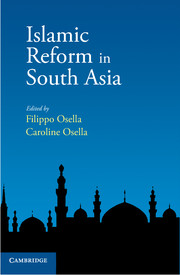Book contents
- Frontmatter
- Contents
- List of Contributors
- Introduction
- Part I Reformist Journeys
- Part II Debating Reform
- Part III Everyday Politics of Reform
- Part IV Reform, State and Market
- 15 Cosmopolitan Islam in a Diasporic Space: Foreign Resident Muslim Women's Halaqa in the Arabian Peninsula
- 16 Jamaat-i-Islami in Bangladesh: Women, Democracy and the Transformation of Islamist Politics
- 17 Secularism Beyond the State: The ‘State’ and the ‘Market’ in Islamist Imagination
- Index
15 - Cosmopolitan Islam in a Diasporic Space: Foreign Resident Muslim Women's Halaqa in the Arabian Peninsula
from Part IV - Reform, State and Market
Published online by Cambridge University Press: 05 January 2014
- Frontmatter
- Contents
- List of Contributors
- Introduction
- Part I Reformist Journeys
- Part II Debating Reform
- Part III Everyday Politics of Reform
- Part IV Reform, State and Market
- 15 Cosmopolitan Islam in a Diasporic Space: Foreign Resident Muslim Women's Halaqa in the Arabian Peninsula
- 16 Jamaat-i-Islami in Bangladesh: Women, Democracy and the Transformation of Islamist Politics
- 17 Secularism Beyond the State: The ‘State’ and the ‘Market’ in Islamist Imagination
- Index
Summary
Over the first 15 years, foreign resident and migrant women have developed a multitude of Islamic study circles or halaqa throughout the Arabian Peninsula (Gulf). While some scholars attribute the development of these study circles to the overall spread of Islamic organizations in the region, I present a contrasting explanation in this essay. Based on several years of fieldwork conducted in the mid- to late-2000s, my discussion points to how conventional analyses are not so much incorrect as they are limited in their scope of analysis. Islamic reformist organizations influence women's halaqa; however, the development of these study circles are part and parcel of a broader set of processes shaping foreign resident and migrant women's religious experiences in the Gulf. Notable here are two factors: women's everyday diasporic uncertainties, and their development of cosmopolitan forms of Islamic practice.
A fieldwork moment prompting me to consider the importance of these processes occurred shortly after one of Auntie Noor's halaqa, gatherings that were attended primarily, if not exclusively by middle and upper-middle class South Asian women residing in Kuwait. The official part of the halaqa had ended. Those of us without pressing engagements or errands to run had moved to the kitchen, where Auntie Noor, our host and organizer of the weekly halaqa, had prepared a lavish meal. Carefully balancing a plate heaped full of pulao and sahlin, I was wending my way through the room when a conversation caught my attention.
- Type
- Chapter
- Information
- Islamic Reform in South Asia , pp. 421 - 444Publisher: Cambridge University PressPrint publication year: 2013

